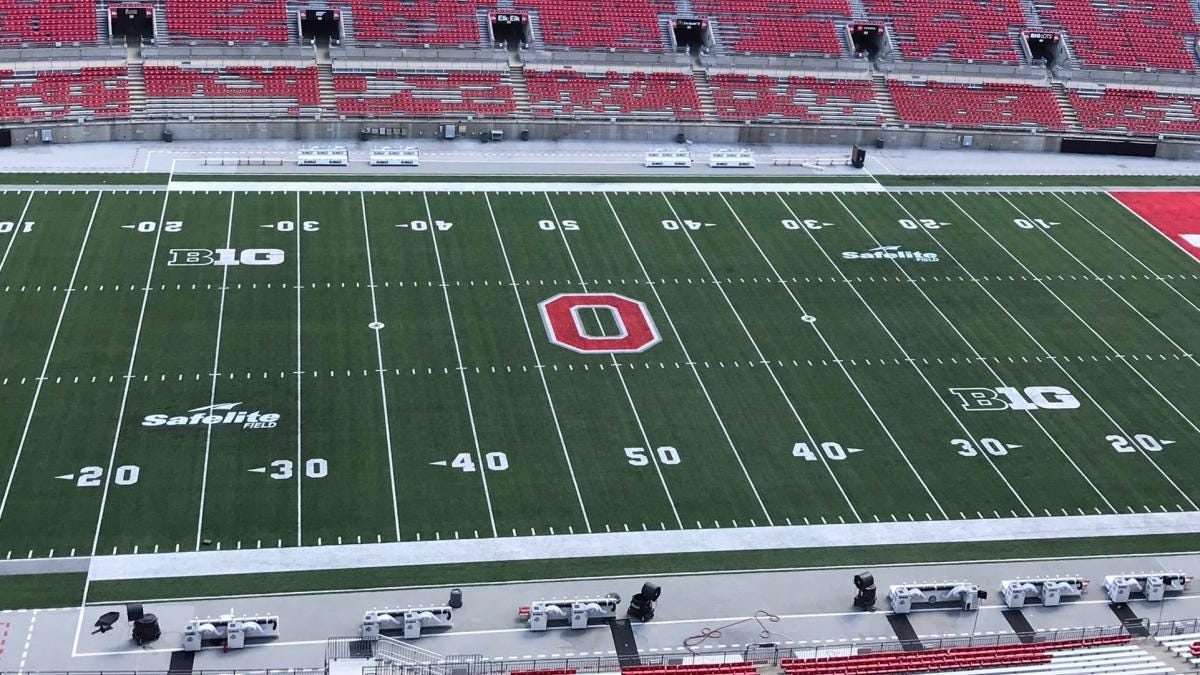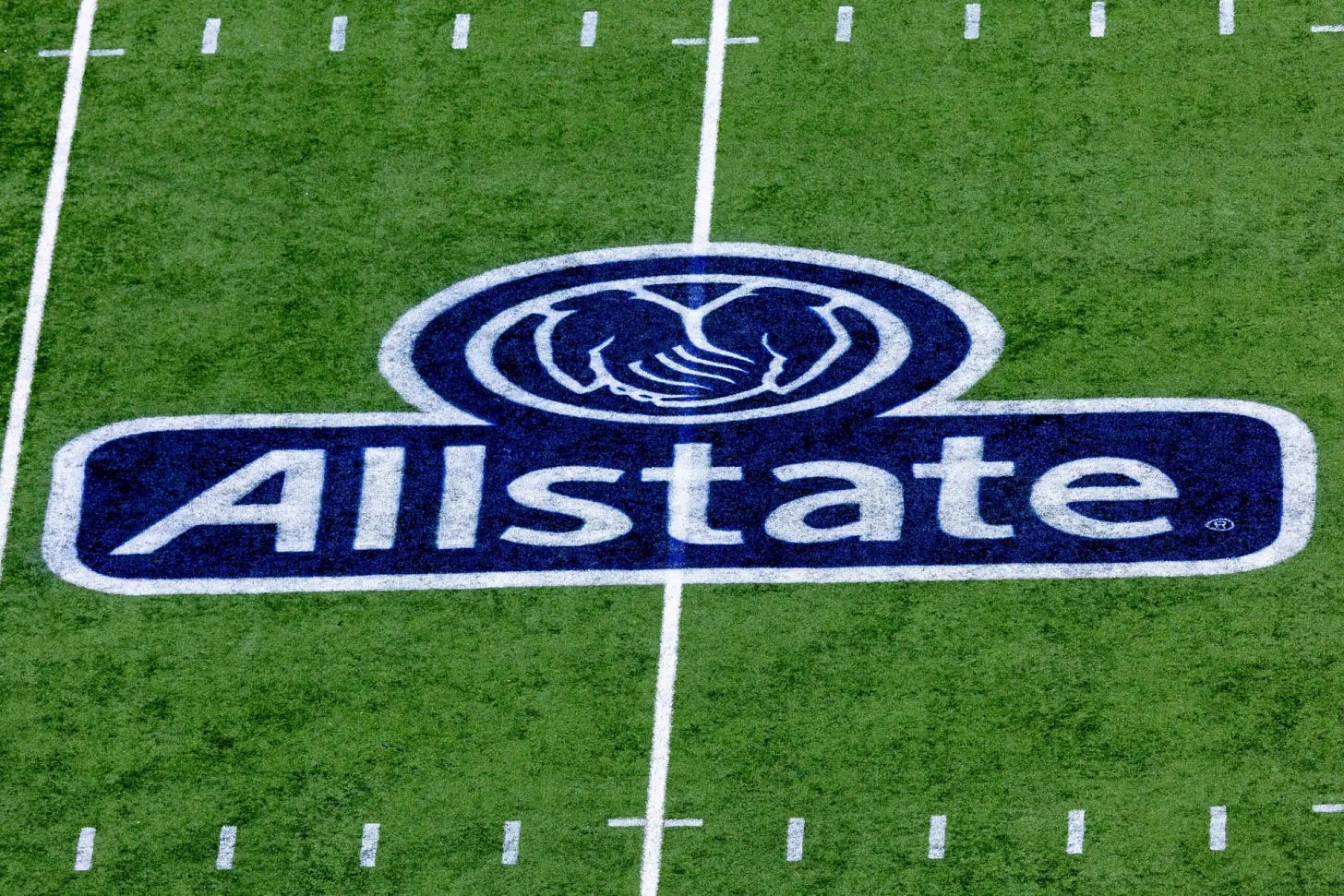🏈 🔵 Could Corporate Sponsors Take Over Conference Naming Rights?
Will the Big 12 become the "Allstate 12" or "Big Allstate Conference?"
Welcome to Blue Chip Journal by Adam Breneman — a 2x per-week newsletter with analysis, hot takes, and news on all things college football, NIL, and recruiting. Subscribe now and join nearly 13,000 other sports fans, and share this newsletter with all the college football fans you know!
Could Corporate Sponsors Take Over Conference Naming Rights?
Hey friends,
The new age of college football is certainly here, and with mandatory Power Four conference revenue sharing on the horizon, it isn’t going anywhere.
Last week, the NCAA and the Playing Rules Oversight Panel approved a proposition allowing programs to place corporate logos at midfield to sell increased advertising rights.
According to USA Today, on-field logo deals could be worth at least $3.8 to $4.2 million per year for “top-level schools in the Power Four conferences.”
In 2022, Safelite Autoglass partnered with Ohio State, claiming Safelite Field at Ohio Stadium for multi-million dollar per year annual partnership.
Now, the company’s logo graces the 24-yardline markers across from the Big Ten logo at The Shoe.
Aside from this recently proposed alteration, a new ring to traditional conference distinctions could be on the horizon, too.
Brett McMurphy and Pete Thamel first reported that the Big 12 is exploring selling its naming rights to a title sponsor.
Per McMurphy, the commercial agreement could become one of the largest in the history of college athletics.
The leading candidate to become the Big 12’s title sponsor is insurance giant Allstate, which is prepared to pay $30 to $50 million annually to the Big 12.
In return, the Big 12 could be renamed the “Allstate 12” or the “Big Allstate Conference.”
Naturally, college football traditionalists and Big 12 fanatics alike weren’t shy about voicing their displeasure for the proposed deal.
But, with each school on the hook for roughly $22 million in student-athlete revenue sharing from Big 12 athletic departments in 2025, the conference might not have another choice.
This newsletter is presented by... PrizePicks
PrizePicks is the easiest way to play daily fantasy. Getting started is very simple — register for an account, make a deposit, and pick more or less on 2-6 player stats to win payouts of up to 25x!
Aside from offering an initial deposit match of up to $100, fans can now use my promo code AdamB for an even BIGGER discount upon downloading the app. Click on the link below to get started today!
“Value creation is the [league’s] number one initiative and priority,” Big 12 commissioner Brett Yormark recently said. “… I don’t look at it as a bad thing.”
Many staunch Big 12 supporters don’t want to see the conference they’ve grown to love be the first to “sell out” to the world of “unnecessary” corporate involvement.
When compared to the sport’s anchors in the Big Ten and SEC, it might have to, as Yormark previously stated.
The Big 12’s media contract with Fox and ESPN runs through 2031, and distributes an average annual payout of $32 million beginning in 2025.
Contrarily, each Big Ten member institution is expected to make three times that amount from its three-network television deal alone.
Nielsen Insights predicts that even with the addition of USC, UCLA, Oregon and Washington, each school will bring in between $80 and $100 million beginning in 2024.
In 2023, each Big Ten school made $60 million prior to the expansion’s finalization.
With each SEC school set to rake in a similar figure, the Big 12 has to make innovative strides to offset the growing cost of college athletics.
The Big 12 isn’t the only conference to reportedly shop its naming rights to a large scale corporation, either.
Ross Dellenger of Sports Illustrated uncovered that Conference USA is “deeply exploring” a similar move, where one of the most storied Group of Five leagues could ink a deal with Globe Life.
While Group of Five programs won’t initially be on the hook for upwards of $20 million in student-athlete revenue sharing, another revenue stream will only help the “have nots” remain on the same playing field as the sport’s elites.
From a traditional sense, I thoroughly understand why these moves aren’t welcomed propositions by college football’s most loyal fans.
Our sport is changing, and most changes can be argued for better or for worse.
However, with the changes, athletic directors and administrations must adapt.
If corporate sponsorships can help offset the growing cost of college athletics, conferences must take the adequate steps necessary in securing lucrative deals, putting student-athletes first.
If you have any questions, comments, or feedback, please don’t hesitate to reach out to me by email at adam@brenemanmedia.com.
You can also find me on Twitter, Instagram, TikTok, LinkedIn or Facebook.
Shoutout to Connor Krause for helping to write this newsletter and putting it together!
Interested in advertising with Blue Chip Journal? Email me.








